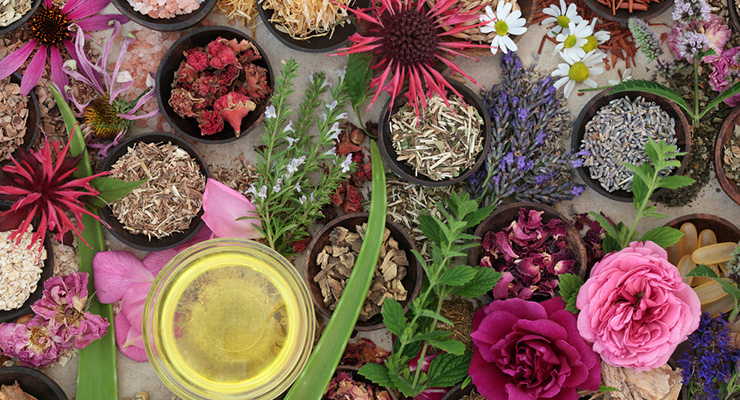As the world’s oldest medical science, with knowledge accumulated over more than 2,000 years, Ayurvedic science stands with solid evidence in treatments today. The Association of Ayurveda with Cosmeceuticals has been of immense importance in the beauty, health and wellness sector.
Today there are thousands of different synthetic cosmetics on the market, all with different combinations of ingredients that have been formulated or manufactured by a heavy chemical process.
In June 2004, Environment California released an issue that reported the adverse chemicals found in synthetic products and their potential health impacts. According to these reports, synthetic products like makeup, shampoo, skin lotion, nail polish, and other personal care products contain chemical ingredients that lack safety data raising major usability concerns.
These synthetic products are relatively overpriced and are often petroleum-based, and some may even require a narrow pH range to be effective which often does more harm than good. To be precise, synthetic products normally possess a pH level of 6-10, whereas the suitable pH for skin falls into 5-6 range.
Ayurveda Herbs for Everyday Skin Care:
Ayurvedic Cosmetics have been used since a long time. In the light of the frequent and intimate nature of the contact on skin and mucous membrane with these Synthetic products, here are some Ayurvedic herbs that will relieve you from commonplace skin disorders without any side effect.
- Chandan (Sandalwood)
Sandalwood well known as Chandan is prized in Ayurveda as an excellent beauty ingredient that is natural, reliable and effective for skin problems such as acne, pimple, dark spots, etc. The natural oils present in sandalwood have anti-inflammatory properties that help with any kind of burning sensation caused due to acne or suntan. Its cooling effect is excellent to get relief from sunburn. Sandalwood causes coagulation of skin proteins, further protecting the skin from any breakouts, allergies or abrasions and tightens your skin pores.
This is precisely why many Ayurveda facial packs use sandalwood as one of their primary ingredients. To make a face pack at home, take 1 tablespoon sandalwood powder, 1 teaspoon coconut oil and some lime juice. Apply it on your face and leave it on for thirty minutes and rinse with lukewarm water and pat dry.
- Amla (Indian Gooseberry)
Indian Gooseberry well known as amla, acts as an antioxidant to treat and heal several health ailments. The antioxidant that strengthens amla is derived from its high-density of ellagitannins such as emblicanin A (37%), emblicanin B (33%), punigluconin (12%) and pedunculagin (14%). Due to high amounts of antioxidants and vitamin C present in amla, it acts as a natural skin brightener. Amla extracts are known for its properties that protect against acne and repairs damaged tissues to give you a clear and glowing skin.
Consuming a teaspoon of powdered amla once in the morning and evening will help in cleansing the system internally and fight acne-related skin condition that causes pimples, blackheads, whiteheads and red inflamed patches of skin.
- Madhuyaṣṭi (Licorice)
Licorice is the root of Glycyrrhiza glabra, its extract is the safest pigment-lightening agent with the fewest side effects. The herb’s root offer skin depigmenting, lightening, emollient, anti-acne, photoprotection, antiaging, antimicrobial and antioxidant properties. These therapeutic properties benefit the skin in all the aspects. Glycyrrhizin acid controls the secretion of melanin in the skin and it has the effect of reducing dark pigmentation and making the complexion fairer. The Root’s extract also helps diminish the appearance of dark under-eye circles, discoloration and age spots.
The extract is produced by boiling the root, evaporating most of the water, and saving the remaining syrup.
- Aloe Vera (AloeBarbadensis Miller)
Aloe Vera Gel has been traditionally used as a natural remedy for burns, minor wounds, and inflammatory skin disorders. It is one of the most prominently used herbs by the cosmetics industry as a hydrating ingredient in liquids, creams, sun lotions, shaving creams, lip balms, healing ointments, and face packs, etc.
The colorless gel contains numerous antioxidants that include beta-carotene, vitamin C and E that helps improve the skin’s natural firmness and further keep it hydrated.
It is a great moisturizer, fights aging and makes your skin look smooth and perfect. For relief from acne, dry skin, sunburn, etc. apply Aloe Vera gel with a cotton swab directly on the acne-affected area three times daily.
- Haldi (Turmeric)
In Ayurvedic practices, turmeric is thought to have many medicinal properties. It’s a traditional herb used in everyday life in many south Asian countries. In many countries, turmeric paste is applied to the skin of the bride and groom before marriage, it is believed to make the skin glow and keep harmful bacteria away from the body. It is currently used as a dominant ingredient in the formulation of several sunscreens. Turmeric contains antioxidants and anti-inflammatory components which is the main reason several multinational companies are involved in making face creams based on turmeric. These characteristics in turmeric provide glow and luster to the skin and also revive your skin by bringing out its natural glow.
When applied to the skin, turmeric can temporarily stain the skin or leave a yellow residue which fades out in some time.
Role of Doshas in Skin Care
The basic perspective of Ayurveda “no two individuals are alike” holds, even when they suffer from seemingly similar ailments. According to Ayurveda, the human body is governed by three fundamental bio-elements, called doshas. Termed as Vata, Kapha and Pitta, they govern physical and mental processes in every human body. Also, the behavior of the skin is determined by the balance of the doshas.
Several factors determine skin health and youthfulness according to Ayurveda. The regulating factors include a good amount of moisture skin balance (Kapha), effective functioning of the metabolic mechanisms that coordinate all the various chemical and hormonal reactions of the skin (Pitta) and lastly, efficient circulation of blood and nutrients to the various layers of the skin (Vata)
- Vata: Fo Vataskin type to stay youthful, go for Ayurvedic herbs which nourishes and rehydrates the skin. The common skin conditions for Vata skin type include wrinkles and premature aging. A massage with warm oil and all-natural moisturizers may help.
- Pitta: For those with pittaskin, it is advisable to adopt good sunscreens for protection from the sun, and facial skin oils should be used daily. This type is affected by heat and sun, burns easily so treatments such as tanning and therapies that expose delicate sensitive skin for several to steam or heat should be avoided.
- Kapha: For people with Kapha skin type, a daily warm oil massage, cleansing and gently exfoliating of the skin should be performed.
Final Thoughts
It is evident how, through the use of synthetic cosmetics, most people are exposed to a variety of potentially harmful chemical-based substances. It is necessary to improve the legislative approach since cosmetic industry continues to adopt the chemicals whose use is not completely safe, yet still allowed, so that it would be suitable to resort to the precautionary principle.
Though over the past two decades, given the evident fruitful findings, the market has been driven toward the Ayurvedic approach by combining traditional and modern medicine and seems to only grow day by day.
Author’s Bio: Dr. Murtaza Jhunjhunwala (BAMS) is the lead Ayurvedic physician at Sadatan. He is a qualified Ayurvedic practitioner who brings a wealth of experience and knowledge in the science. Prior to Sadatan, he has worked at a prestigious Hospital in Mumbai where he still continues his association in a consulting capacity.
Website: [https://www.sadatan.com/]

















